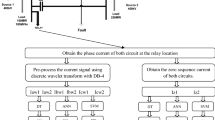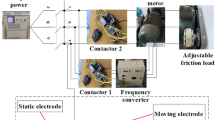Abstract
This paper presents a new method for fault classification in series-compensated transmission line using multiclass support vector machine (MCSVM) and multi class extreme learning machine (MCELM). These methods use the information obtained from the wavelet decomposition of fault current signals for fault classification. Using MATLAB simulink, data set has been generated with different types of fault and system variables, which include the fault resistance, fault distance, load angle and fault inception angle. The proposed method has been tested on a 400-kV, 300-km transmission line under variety of fault conditions. The performance of MCSVM and MCELM is compared in terms of training time and classification accuracy. The comparisons have been made for both One-Versus-One and One-Versus-Rest methods of SVMs and ELMs. Results show that MCELMs need less training time compared to MCSVMs, and the classification accuracy of MCELMs is more or less similar to MCSVMs. The feasibility of the proposed methods is also tested on a practical 220-kV series-compensated transmission line, and the results obtained are quite promising.




Similar content being viewed by others
References
Saha MM et al (1999) A new accurate fault location algorithm for series compensated lines. IEEE Trans Power Deliv 14:789–797
Phadke AG, Thorp JS (1988) Computer relaying for power systems. Wiley, Taunton
Girgis AA, Sallam AA, Karim El-Din A (1998) An adaptive protection scheme for advanced series compensated transmission lines. IEEE Trans Power Deliv 13:414–420
Pradhan AK, Routray A, Biswal B (2004) Higher order statistics-Fuzzy integrated scheme for fault classification of a series compensated line. IEEE Trans Power Deliv 19:891–893
Pradhan AK, Routray A, Pati S, Pradhan DK (2005) Wavelet Fuzzy combined approach for fault classification of a series compensated transmission line. IEEE Trans Power Deliv 19:1612–1618
Biswarup D, Vittal Reddy J (2005) Fuzzy-logic-based fault classification scheme for digital distance protection. IEEE Trans Power Deliv 20:609–616
Abdelaziz AY, Ibrahim AM, Mansour MM, Talaat HE (2005) Modern approaches for protection of series compensated transmission lines. Electr Power Syst Res 75:85–98
Dash PK, Pradhan AK, Panda G (2003) Application of artificial intelligence techniques for fault classification and location of faults on Thyristor controlled series compensated line. Electr Power Compon Syst 31:241–260
Martin F, Aguado JA (2003) Wavelet based ANN approach for transmission line protection. IEEE Trans Power Deliv 186:1572–1574
Nan Z, Mladen K (2007) Transmission line boundary protection using wavelet transform and neural network. IEEE Trans Power Deliv 22:859–869
Urmil BP, Bhavesh RB, Rudra PM, Biswarup D (2007) Decision tree based fault classification scheme for protection of series compensated transmission line. Int J Emerg Electr Power Syst 8:1–6
Dash PK, Samantaray SR, Panda Ganapathy (2007) Fault classification and section identification of an advanced series compensated transmission line using support vector machine. IEEE Trans Power Deliv 22:67–73
Urmil BP, Biswarup D, Rudra PM (2008) Combined wavelet-SVM technique for fault zone detection in a series compensated transmission line. IEEE Trans Power Deliv 23:1789–1794
Cortes C, Vapnik VN (1995) Support vector networks. Mach Learn 20:273–297
Vapnik VN (1995) The nature of statistical learning theory. Springer, Berlin
Vapnik VN (1998) The statistical learning theory. Wiley, New York
Guang-Bin H, Qin-Yu Z, Chee-Kheong S (2006) Extreme learning machine: theory and applications. Neurocomputing 70:489–501
Nan-Ying L, Paramasivam S, Guang-Bin H (2006) Classification of mental tasks from EEG signals using extreme learning machine. Int J Neural Syst 16:29–38
Author information
Authors and Affiliations
Corresponding author
Appendix 1
Appendix 1
-
Source data at both sending and receiving ends of the line:
-
Positive sequence impedance: 1.31 + j15.0 Ω.
-
Zero sequence impedance: 2.33 + j26.6 Ω.
-
System frequency: 50 Hz.
-
Transmission line data:
-
Length of the line: 300 km
-
Voltage: 400 kV
-
Positive sequence impedance: 8.25 + j94.5 Ω
-
Zero sequence impedance: 82.5 + j308 Ω
-
Positive sequence capacitance: 13 nF/km.
-
Zero sequence capacitance: 8.5 nF/km.
Rights and permissions
About this article
Cite this article
Malathi, V., Marimuthu, N.S. & Baskar, S. A comprehensive evaluation of multicategory classification methods for fault classification in series compensated transmission line. Neural Comput & Applic 19, 595–600 (2010). https://doi.org/10.1007/s00521-009-0312-9
Received:
Accepted:
Published:
Issue Date:
DOI: https://doi.org/10.1007/s00521-009-0312-9




